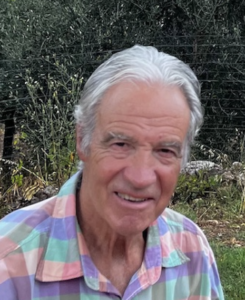 As the daughter of a Pan Am Captain in the 60’s, Lucia Renshaw learned to navigate before she learned to drive. She had a full passport before she had a savings account. And she knew the Pan Am flight schedule better than she knew her class schedules. What she didn’t know was the story about her father’s role in WWII.
As the daughter of a Pan Am Captain in the 60’s, Lucia Renshaw learned to navigate before she learned to drive. She had a full passport before she had a savings account. And she knew the Pan Am flight schedule better than she knew her class schedules. What she didn’t know was the story about her father’s role in WWII.
Not that she didn’t try. One time, while holding up a calendar of famous Pan Am “first flight” planes, she asked her father, “which ones did you fly?” He replied simply and shortly: “All of them.”
Four years ago, she started poking around to find his story. When she uncovered a thread of a story about her father, then Lt. C. Downer Renshaw (USAAC), flying Photo Reconnaissance in the Caribbean in 1939, she pulled the thread. What she found launched her into the story of pre-war political intrigue, Pan Am’s roles in World War II, and the excitement of the then new field of aviation.
In elaborate deals forged by Pan Am’s founder Juan Trippe and FDR himself, the airline created a supply chain that ran from Miami all the way to the top of the world in China. And DMA member Don Loomis’ dad was one of the pilots.
Lucia, whose father also took part in this vital war effort, will tell the story of these secret missions and give history of the airline throughout its wartime operation.
Lucia Renshaw was born and raised in Westport, CT, and went to Staples High School. In 1975, she graduated with degrees in Business and Political Science from the University of San Francisco. It’s a long way from Westport made even longer by the fact that to get there by Pan Am, she had to fly first to London or Guatemala.
After a 35-year career in Marketing Management in Financial Services, she was able to expand her hobby of family history research. Her real passion lies in helping people discover the history of their ancestors who served in the Civil War and World War II. She is currently using her skills to find the children of her father’s colleagues from the war years of Pan Am to share what she has learned with them. Don Loomis, Jr. was one of those treasured finds.
Lucia currently lives in Phoenix, Arizona with her husband, Bruce Covill.
 Don Loomis is an active DMA member, having presented recently in the Current Affairs group on Voting Rights and with Mark Nunan on the war in Ukraine.
Don Loomis is an active DMA member, having presented recently in the Current Affairs group on Voting Rights and with Mark Nunan on the war in Ukraine.
Don Loomis is a graduate of Georgetown University’s School of Foreign Service. He spent three years active duty with the US Navy concluding as CIC Officer aboard USS Hammerberg DE-1015; eight years residency in Rome, Italy while working as a consultant with Syncronamics; returning to the US in 1978 he worked in shipping and concluded as senior consultant with Fisher International in Norwalk, where acquired language skills in French, Spanish and Italian were instrumental in building a world-wide database on the pulp and paper industry. Don has been retired since 2014. Don, and his wife Daniela, split their time between Darien and Daniela’s family home in Formia, Italy . . . when not visiting daughter Deborah and 3 grandchildren in Washington DC.
Both Don, and Lucia’s dads, joined Pan Am in August 1940 and went on to participate in what became a crucial logistics supply route across the South Atlantic, over Africa, out to India where supplies were then flown “Over the Hump” into China – this vital logistics life-line became known as . .. The CannonBall Express!!
Summary
Don Loomis, a DMA member, and Lucia Renshaw, who grew up in Westport, connected through their fathers’ work with Pan American Airways (Pan Am) during World War II. The presentation revealed Pan Am’s crucial role in secret supply missions to China and other parts of the world during the war (and even before the US entered the war).
Lucia Renshaw shared her personal story of discovering her father’s role in World War II, despite him never speaking about it during her childhood. Her father, a Pan Am pilot, was part of the company’s involvement in creating a vital logistics supply route, known as the “Cannonball Express,” which spanned from Miami to Brazil, across the South Atlantic to Africa, and then first to help the British at El Alamein, then extended to India, where materiel was sent over The Hump to equip the Chinese in fighting the Japanese. Lucia’s journey of uncovering her father’s contributions led her to dive into the broader history of Pan Am’s involvement in the war effort.
Don Loomis pointed out that his father and Lucia’s trained together for the young Army Air Force before being seconded to Pan Am on the same day in August 1940 along with over 100 other US Army pilots when Pan Am agreed to help the supply effort but needed more pilots. Both men participated in what became a critical logistics operation that helped support the war. Pan Am, under the leadership of its founder Juan Tripp, became instrumental in building a global aerial supply route, which included constructing airfields in Central and South America and Africa and facilitating the transport of military supplies (and planes for our allies) across vast distances. This operation involved forging deals between Pan Am, the U.S. government, and international allies to create the infrastructure necessary to support the war effort. To all accounts, this was done more expeditiously (and secretly) than if the government itself had undertaken it.
The presentation touches on the geopolitical context of the time, such as Germany’s growing influence in South America and its control of airlines in the region, which posed a threat to the Panama Canal and other US strategic interests in the Caribbean. The U.S. government, in collaboration with Pan Am, worked to eliminate Axis control of South American airlines (which required German pilots and crews) and build a system of air bases under the guise of commercial development.
Lucia detailed the challenging conditions faced by pilots during these missions. Planes were often stripped down to bare essentials; crews had to navigate dangerous and unpredictable weather conditions over vast distances in aircraft which were often without oxygen or pressurized cabins. Pan Am continued to develop refined routing, weather forecasting, and crew rotation to enhance efficiency eventually reducing supply times from over 40 days to over 40 hours. It also involved setting up an African airline network, which invoked recollections of a former DMA member and father-in-law to a current member who had been a pilot in Pan American Airways Africa.
The presentation concluded with a discussion on the legacy of Pan Am’s wartime operations and the personal connections between the presenters’ families. Pan Am’s efforts were recognized as a significant contribution to the Allied victory, and its work during World War II left a lasting impact on aviation and global logistics.
